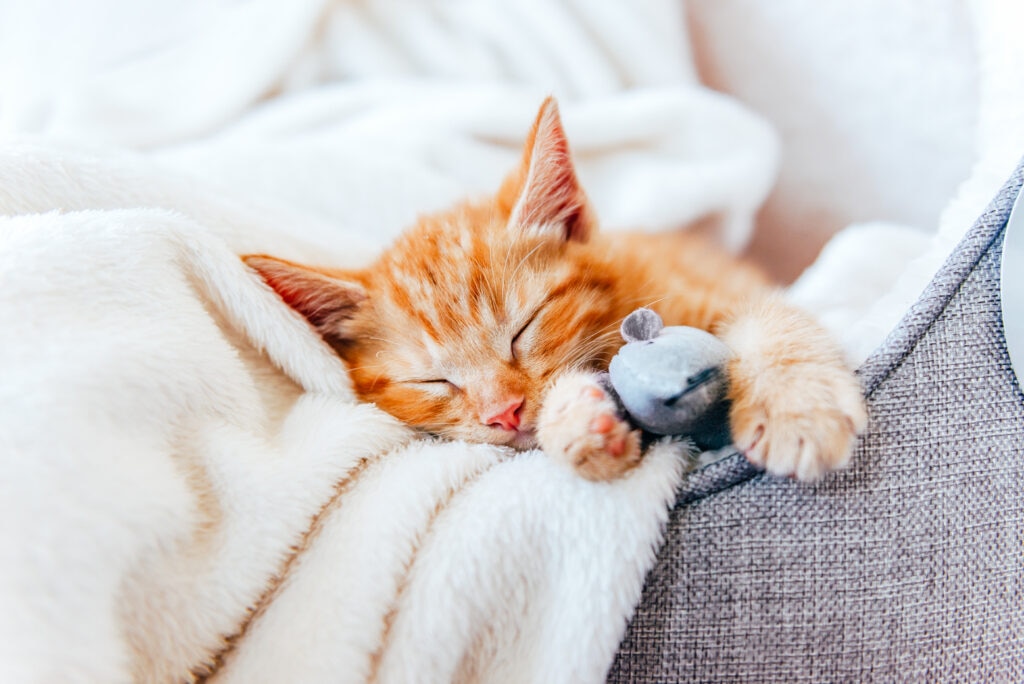Do Cats Dream?

Photo by Manuta / iStock / Getty Images Plus
If you’ve ever watched your cat sleeping soundly, with paws twitching and whiskers flicking, you’ve probably wondered: Do cats dream? And, if so, what do cats dream about? The short answer is yes, they do, and it’s complicated.
Here’s the science behind cat dreams, what your cat might be dreaming about, and how to tell if your feline friend is dreaming.
Do Cats Dream?
Experts say that, like most other mammals, cats experience dreams during sleep. So, while you’re dreaming at night, your cat might be having some vivid dreams of their own.
As with humans, feline dreams occur during a stage of sleep known as rapid eye movement (REM).
Elizabeth Stelow, DVM, DACVB, the chief of behavior science at UC Davis School of Veterinary Medicine in California, says that we’ve actually known this for decades. A 1979 study confirmed that felines have dreams of their own.
The study “allowed us, for the first time, to connect things we see in the human dream state to cats,” Dr. Stelow says. It also offered evidence that cats dream about natural feline activities, like chasing mice or birds.
Recognizing that cats dream can also shape how we view and treat them, she notes. “Knowing that cats dream helps us to build our compassion for them and celebrate how similar we really are,” Dr. Stelow explains.
What Do Cats Dream About?
“The theory of dream is that animals, including cats and humans, relive natural behaviors during sleep,” Dr. Stelow says. “In the case of cats, that might be hunting, playing, eating, fighting, or grooming.”
Further evidence comes from a 2001 MIT study in which rats were trained to run a maze. Researchers recorded their brain activity during the task and again during REM sleep, finding nearly identical patterns. This suggests the rats were likely dreaming about navigating the maze they had practiced earlier that day—and it’s not a stretch to think that cats would behave the same way.
You can also sometimes make an educated guess about what your cat might be dreaming about based on their movements and sounds. If your cat’s paws are twitching, tail flicking, or whiskers fluttering, it may be that they’re dreaming about chasing something. Gentle vocalizations may signal a social dream, such as interacting with a human or another pet.
Still, while studies and behaviors give us clues, we can’t know for certain what cats dream about, researchers say. The evidence suggests their dreams are tied to real-life experiences, but the exact details remain a mystery.
How To Tell If Your Cat Is Dreaming
There are clear signs that your cat is dreaming. You can sometimes even guess what they’re dreaming about based on their movements and sounds.
Here’s what to watch for.
- Twitching: A cat twitching in their sleep, whether it’s their ears, paws, tail, or whiskers, is one of the most common signs of dreaming.
- Vocalizing: Soft meows, chirps, or other noises suggest your cat may be “talking” in a dream.
- Rapid eye movement: If you look closely, you might see your cat’s eyes moving quickly beneath their closed lids during REM sleep.
- Paw movements: Some cats paddle their paws or even make running motions while dreaming.
- Breathing changes: Slight changes in breathing patterns, like faster or more shallow breaths, can accompany active dreams.
“In most cases, these small twitches and sounds are completely normal and just signs your cat is in REM sleep,” says Jamie Richardson, head of veterinary medicine at Small Door Veterinary.
“Seizures during sleep are rare, but if you see extreme movements along with symptoms like stiffening with an arched back and more repetitive limb movements, it could be a sign of something more serious, and you should seek veterinary care,” Dr. Richardson adds.
Do Cats Have Nightmares?
While there’s no definitive scientific proof that cats can have nightmares like humans do, Dr. Stelow says we can make educated guesses based on what we know about human dreaming.
The leading theory behind why humans dream is that the brain uses memories from the day and past experiences to rehearse possible responses to common situations, Dr. Stelow explains.
“The idea is that if we can practice while we’re asleep and our brain is flexible, we may maximize our success in facing these stimuli in waking life,” Dr. Stelow says.
So can cats have nightmares?
Possibly. They might dream about being chased or even getting into a fight. Signs might include distressed sounds, more intense twitching, or waking up suddenly and anxiously.
If this happens, don’t wake them, but give your bestie a calm atmosphere to decompress when they do get up. After all, you know how scary nightmares are—our cats probably feel the same way.
FAQs About Cat Dreaming
Q: Do cats dream about their pet parents?
A: It’s very possible. Given that many cats form strong bonds with their humans, it’s likely your cat dreams about you.
Q: How much do cats sleep?
A: Adult cats typically sleep 12 to 16 hours a day. Kittens and senior cats often sleep up to 20 hours a day.
Q: Should you wake your cat if they’re having a bad dream?
A: “It’s best not to wake a dreaming cat, even if it seems like they’re having a nightmare,” Dr. Richardson says. “Cats can become disoriented or even lash out when abruptly woken from deep sleep, especially during REM.” Rest assured, the dream won’t harm them, and they usually return to their usual selves quickly.
Q: Why does my cat twitch in their sleep?
A: Twitching during sleep is usually a sign that your cat is dreaming. Small movements like paw twitches, whisker flicks, ear flicks, or tail flicks often happen as they “act out” parts of their dreams.
Attributions
This content was medically reviewed by Hannah Hart, DVM, Chewy veterinarian.



